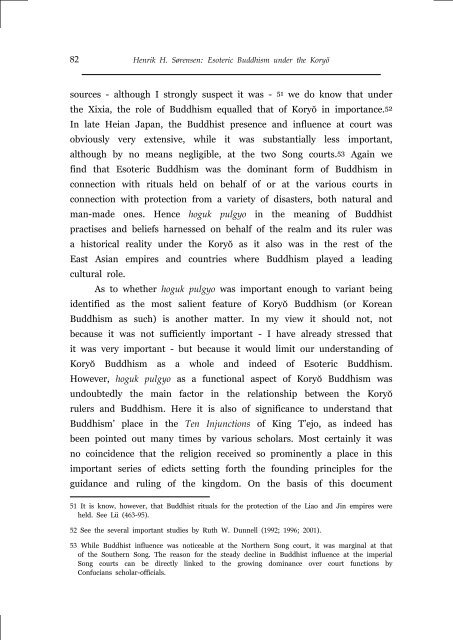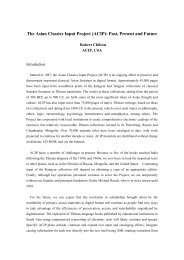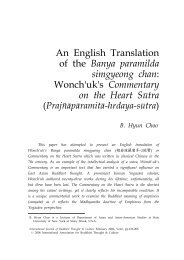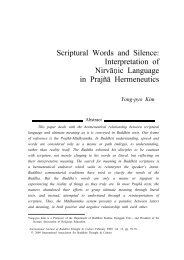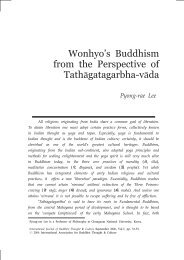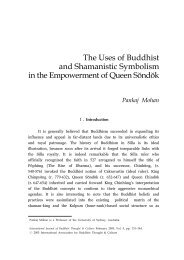Esoteric Buddhism under the KoryÅ in the Light of ... - Buddhism.org
Esoteric Buddhism under the KoryÅ in the Light of ... - Buddhism.org
Esoteric Buddhism under the KoryÅ in the Light of ... - Buddhism.org
You also want an ePaper? Increase the reach of your titles
YUMPU automatically turns print PDFs into web optimized ePapers that Google loves.
82<br />
Henrik H. Sørensen: <strong>Esoteric</strong> <strong>Buddhism</strong> <strong>under</strong> <strong>the</strong> Koryŏ<br />
sources - although I strongly suspect it was - 51 we do know that <strong>under</strong><br />
<strong>the</strong> Xixia, <strong>the</strong> role <strong>of</strong> <strong>Buddhism</strong> equalled that <strong>of</strong> Koryŏ <strong>in</strong> importance. 52<br />
In late Heian Japan, <strong>the</strong> Buddhist presence and <strong>in</strong>fluence at court was<br />
obviously very extensive, while it was substantially less important,<br />
although by no means negligible, at <strong>the</strong> two Song courts. 53 Aga<strong>in</strong> we<br />
f<strong>in</strong>d that <strong>Esoteric</strong> <strong>Buddhism</strong> was <strong>the</strong> dom<strong>in</strong>ant form <strong>of</strong> <strong>Buddhism</strong> <strong>in</strong><br />
connection with rituals held on behalf <strong>of</strong> or at <strong>the</strong> various courts <strong>in</strong><br />
connection with protection from a variety <strong>of</strong> disasters, both natural and<br />
man-made ones. Hence hoguk pulgyo <strong>in</strong> <strong>the</strong> mean<strong>in</strong>g <strong>of</strong> Buddhist<br />
practises and beliefs harnessed on behalf <strong>of</strong> <strong>the</strong> realm and its ruler was<br />
a historical reality <strong>under</strong> <strong>the</strong> Koryŏ as it also was <strong>in</strong> <strong>the</strong> rest <strong>of</strong> <strong>the</strong><br />
East Asian empires and countries where <strong>Buddhism</strong> played a lead<strong>in</strong>g<br />
cultural role.<br />
As to whe<strong>the</strong>r hoguk pulgyo was important enough to variant be<strong>in</strong>g<br />
identified as <strong>the</strong> most salient feature <strong>of</strong> Koryŏ <strong>Buddhism</strong> (or Korean<br />
<strong>Buddhism</strong> as such) is ano<strong>the</strong>r matter. In my view it should not, not<br />
because it was not sufficiently important - I have already stressed that<br />
it was very important - but because it would limit our <strong>under</strong>stand<strong>in</strong>g <strong>of</strong><br />
Koryŏ <strong>Buddhism</strong> as a whole and <strong>in</strong>deed <strong>of</strong> <strong>Esoteric</strong> <strong>Buddhism</strong>.<br />
However, hoguk pulgyo as a functional aspect <strong>of</strong> Koryŏ <strong>Buddhism</strong> was<br />
undoubtedly <strong>the</strong> ma<strong>in</strong> factor <strong>in</strong> <strong>the</strong> relationship between <strong>the</strong> Koryŏ<br />
rulers and <strong>Buddhism</strong>. Here it is also <strong>of</strong> significance to <strong>under</strong>stand that<br />
<strong>Buddhism</strong>’ place <strong>in</strong> <strong>the</strong> Ten Injunctions <strong>of</strong> K<strong>in</strong>g T’ejo, as <strong>in</strong>deed has<br />
been po<strong>in</strong>ted out many times by various scholars. Most certa<strong>in</strong>ly it was<br />
no co<strong>in</strong>cidence that <strong>the</strong> religion received so prom<strong>in</strong>ently a place <strong>in</strong> this<br />
important series <strong>of</strong> edicts sett<strong>in</strong>g forth <strong>the</strong> found<strong>in</strong>g pr<strong>in</strong>ciples for <strong>the</strong><br />
guidance and rul<strong>in</strong>g <strong>of</strong> <strong>the</strong> k<strong>in</strong>gdom. On <strong>the</strong> basis <strong>of</strong> this document<br />
51 It is know, however, that Buddhist rituals for <strong>the</strong> protection <strong>of</strong> <strong>the</strong> Liao and J<strong>in</strong> empires were<br />
held. See Lü (463-95).<br />
52 See <strong>the</strong> several important studies by Ruth W. Dunnell (1992; 1996; 2001).<br />
53 While Buddhist <strong>in</strong>fluence was noticeable at <strong>the</strong> Nor<strong>the</strong>rn Song court, it was marg<strong>in</strong>al at that<br />
<strong>of</strong> <strong>the</strong> Sou<strong>the</strong>rn Song. The reason for <strong>the</strong> steady decl<strong>in</strong>e <strong>in</strong> Buddhist <strong>in</strong>fluence at <strong>the</strong> imperial<br />
Song courts can be directly l<strong>in</strong>ked to <strong>the</strong> grow<strong>in</strong>g dom<strong>in</strong>ance over court functions by<br />
Confucians scholar-<strong>of</strong>ficials.


